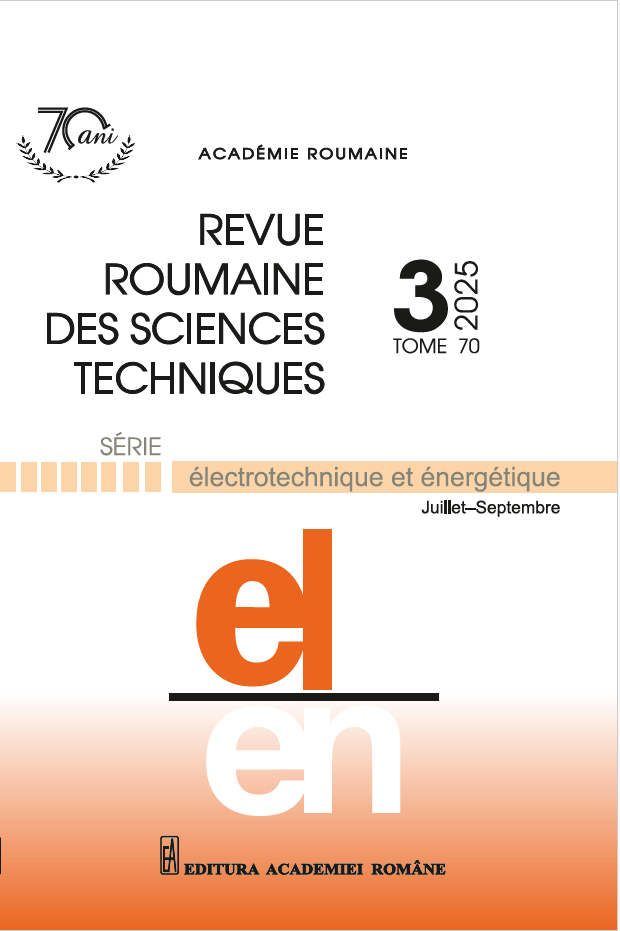CONTRÔLE ROBUSTE DE L'ÉNERGIE ÉOLIENNE À L'AIDE DU MODE GLISSANT, DU RETOUR EN ARRIÈRE ET DE LA LOGIQUE FLOUE
DOI :
https://doi.org/10.59277/RRST-EE.2025.3.5Mots-clés :
Générateur à induction à double alimentation, Contrôle de mode glissant, Contrôle de rétrogradation, Logique floue, Hybride, Contrôle de puissanceRésumé
Cet article présente une nouvelle approche de contrôle non linéaire pour un générateur à induction à double alimentation (DFIG) intégrant le contrôle par mode glissant, le contrôle par rétroaction et la logique floue. La stratégie hybride proposée modifie le contrôleur par mode glissant en conservant la commande équivalente tout en remplaçant le contrôle attractif par le rétroaction. La logique floue de type 1 est ensuite utilisée pour optimiser les gains de stabilisation du contrôleur par rétroaction, améliorant ainsi la stabilité et la résilience du système. L'efficacité du contrôle proposé est évaluée par simulations MATLAB/Simulink. Les résultats du test de suivi montrent un suivi précis de la trajectoire de référence sans dépasser les limites de puissance active et réactive ni présenter d'erreurs en régime permanent. Lors du test de régulation, le système a démontré une sensibilité aux variations brusques de vitesse, tout en maintenant des puissances active et réactive stables.
Références
(1) R. Rouabhi, A. Herizi, A. Djerioui, Performance of robust type-2 fuzzy sliding mode control compared to various conventional controls of doubly-fed induction generator for wind power conversion systems, Energies, 17, 3778, pp. 1–25 (2024).
(2) E. Farah, Y. Ihedrane, B. Bossouf, M. Bouderbala, S. Motahhir, M. Masud, S. Aljahdali, M. El Ghamrasni, Robust sliding Backstepping mode control of a wind system based on the DFIG generator, Scientifc Reports, 12, 11782, pp. 1–16 (2022).
(3) S. Kouadria, E. Berkouk, Y. Messlem, M, Denai, Improved control strategy of DFIG-based wind turbines using direct torque and direct power control techniques, Journal of. Renewable and Sustainable Energy, 10, 4, pp. 1–21, (2018).
(4) C.R. Raghavendran, J.P. Roselyn, D. Devaraj, Development and performance analysis of intelligent fault ride through controls chemein the dynamic behaviour of grid connected DFIG based wind systems, Energy Reports, 6, pp. 2560–2576 (2020).
(5) B. Desalegn, D. Gebeyehu, B. Tamrat, Wind energy conversion technologies and engineering approaches to enhancing wind power generation, Heliyon, 8, pp. 1–21 (2022).
(6) Y. Sahri, S. Tamalouzt, S.L. Belaid, M. Bajaj, S.S. Ghoneim, H.M. Zawbaa, S. Kamel, Performance improvement of Hybrid System-based DFIG-Wind/PV/Batteries connected to DC and AC grid by applying Intelligent Control, Energy Reports, 9, pp. 2027–2043 (2023).
(7) R. Rouabhi, A. Herizi, S. Djeriou, A. Zemmit, Hybrid type-1 and 2 fuzzy sliding mode control of the induction motor, Revue Roumaine des Sciences Techniques, Série Électrotechnique et Énergétique, 69, 2, pp. 147–152 (2024).
(8) C. Hamid, A. Derouich, M. Taoussi, O. Zamzoum, A. Hanafi, An improved performance variable speed wind turbine driving a doubly fed induction generator using sliding mode strategy. IEEE 2nd International Conference on Electronics, Control, Optimization and Computer Science (ICECOCS), Kenitra, Morocco, (2020).
(9) B. Kelkoul, A. Boumediene, Stability analysis and study between classical sliding mode control (SMC) and super twisting algorithm (STA) for doubly fed induction generator (DFIG) under wind turbine, Energy, 214 (2021).
(10) A. Herizi, R. Rouabhi, A. Zemmit, Comparative study of the performance of a sliding, sliding-fuzzy type 1 and a sliding-fuzzy type 2 control of a permanent magnet synchronous machine, Przegląd Elektrotechniczny, 98, 11, pp. 21–29 (2022).
(11) A. Ghalem, A. Naceri, Y. Djeriri, Backstepping control of a wind energy conversion system based on a DFIG connected to the grid, Przegląd Elektrotechniczny, 99, 12, pp. 98–103 (2023).
(12) A. Herizi, R. Rouabhi, A. Zemmit, Speed control of doubly fed induction motor using backstepping control with interval type-2 fuzzy controller, Diagnostyka, 24, 3, pp. 1-8 (2023).
(13) A. Herizi, A. Benyounes, R. Rouabhi, A. boudras, F. Ouagueni, A. Zemmit, Robust fuzzy – backstepping mode control of an induction motor, Studies in Engineering and Exact Sciences, 5, 1, pp. 1317-1334 (2024).
(14) A. Benyounes, A. Herizi, M. Zegait, M. Bouras, B. Nail, I.E. Tibermacine, Fuzzy backstepping control for enhanced stability of a quadrotor unmanned aerial vehicle, Studies in Engineering and Exact Sciences, 5, 1, pp. 746-769 (2024).
(15) C. Dualibe, M. Verleysen, P.G.A. Jespers, Design of analog fuzzy logic controllers in CMOS technologies, Kluwer Academic Publishers, New York (2003).
(16) R. Lowen, A. Verschoren, Foundations of generic optimization, Volume 2: applications of fuzzy control, genetic algorithms and neural networks, Springer (2008).
(17) M. Errouha, A. Derouich et al., Optimization and control of water pumping PV systems using fuzzy logic controller, Energy Reports, 5, pp. 853–865 (2019).
(18) M.S. Adouairi, B. Bossoufi, S. Motahhir, I. Saady, Application of fuzzy sliding mode control on a single-stage grid-connected PV system based on the voltage-oriented control strategy, Results in Engineering, 17, pp. 1–9 (2023).
(19) A.J.G. Malar, C.A. Kumar, A.G. Saravanan, Iot based sustainable wind green energy for smart cities using fuzzy logic based fractional order darwinian particles warm optimization, Measurement, 166 (2020).
(20) A. Herizi, A. Zemmit, R. Rouabhi, F. Ouagueni, New design of robust controller based on fuzzy 12 linguistic variables for wind power conversion system, Przegląd Elektrotechniczny, 100, 10, pp. 89–92 (2024).
(21) H.H.H. Mousa, A. Youssef, E.E.M. Mohamed, Hybrid and adaptive sectors P&O MPPT algorithm based wind generation system, Renewable Energy, 145, pp. 1412-1429 (2020).
(22) M. Ahmad Soomro, Z. Ahmad Memon, M. Kumar, M. Hussain Baloch, Wind energy integration: Dynamic modeling and control of DFIG based on super twisting fractional order terminal sliding mode controller, Energy Reports, 7, pp. 6031-6043 (2021).
(23) A. Herizi, R. Rouabhi, S. Krim, E. Hachi, Hybrid control using fuzzy sliding mode control of doubly fed induction machine, Oum El Bouaghi, Algeria (2021).
Téléchargements
Publiée
Numéro
Rubrique
Licence
(c) Copyright REVUE ROUMAINE DES SCIENCES TECHNIQUES — SÉRIE ÉLECTROTECHNIQUE ET ÉNERGÉTIQUE 2025

Ce travail est disponible sous licence Creative Commons Attribution - Pas d'Utilisation Commerciale - Pas de Modification 4.0 International.


